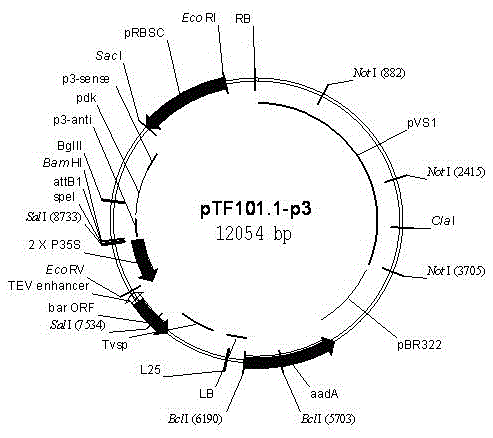Method for culturing anti-soybean-mosaic-virus transgenic plants
A soybean mosaic virus and transgenic plant technology, applied in the field of plant biology, can solve the problems of interfering or affecting the pathogenicity of SMV, affecting the host range of SMV, etc.
- Summary
- Abstract
- Description
- Claims
- Application Information
AI Technical Summary
Problems solved by technology
Method used
Image
Examples
Embodiment 1
[0030] Example 1. Discovery of Fragments with the Function of Inhibiting Soybean Mosaic Virus
[0031] Sequence comparison of 26 SMV strains registered in GenBank (http: / / www.ncbi.nlm.nih.gov / genbank / ) revealed that there is a conserved region in the P3 gene of soybean mosaic virus. A 302bp fragment was finally determined, located at the 99th-400th nucleotides from the 5' end of the P3 gene, as shown in SEQ-2. The RNA encoded by this fragment is expected to inhibit soybean mosaic virus. The RNA sequence transcribed from the SEQ-2 fragment is the single-stranded RNA shown in SEQ-1.
Embodiment 2
[0032] Example 2. Acquisition and identification of transgenic plants resistant to soybean mosaic virus
[0033] 1. Construction of RNAi recombinant plasmid
[0034] (1) Synthesize the double-stranded DNA molecule shown in SEQ-2 of the sequence listing.
[0035] (2) Using the double-stranded DNA molecule synthesized in step 1 as a template, using the primer pair composed of SMV-P3-F and SMV-P3-R, perform PCR amplification with KODFX high-fidelity enzyme (TOYOBO, Japan),
[0036] Obtain the PCR amplification product.
[0037] SMV-P3-F: 5'-CCG CTCGAGTCTAGA TCTCTTGATGGGCTTGGTTTC-3'
[0038] SMV-P3-R: 5'-GG GGTACCAAGCTT GGTTGTTGGATGCTTTTCTTTC-3'
[0039] In SMV-P3-F and SMV-P3-R, the restriction endonuclease recognition sequence is underlined, where "CTCGAG" is the restriction endonuclease XhoI restriction endonuclease recognition sequence, "TCTAGA" is the restriction endonuclease XbaI restriction endonuclease recognition sequence Recognition sequence, "GGTACC" is the reco...
PUM
 Login to View More
Login to View More Abstract
Description
Claims
Application Information
 Login to View More
Login to View More - R&D
- Intellectual Property
- Life Sciences
- Materials
- Tech Scout
- Unparalleled Data Quality
- Higher Quality Content
- 60% Fewer Hallucinations
Browse by: Latest US Patents, China's latest patents, Technical Efficacy Thesaurus, Application Domain, Technology Topic, Popular Technical Reports.
© 2025 PatSnap. All rights reserved.Legal|Privacy policy|Modern Slavery Act Transparency Statement|Sitemap|About US| Contact US: help@patsnap.com



